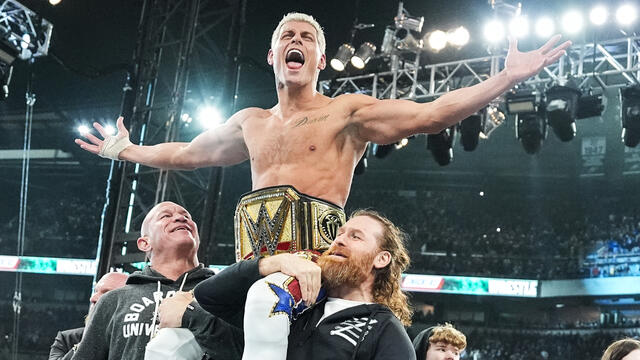Two Olympians from the United States — one a silver medalist in judo, the other a ripped Greco-Roman wrestler— lock up the center of the ring. The clinch tightens as they jockey for position, working angles and scraping forearms across jaws.
“Break,” calls WWE Performance Center coach Robbie Brookside before signaling for a fresh match-up.
Another Olympic grappler, this one a rugged heavyweight, steps forward, ready to lock up with one of the top kickboxers in the world.
That was the scene at an invitation-only workout held earlier this month at the WWE Performance Center. The camp consisted entirely of high-level beginners — in this case, elite combat athletes. WWE hosts a handful of such tailored workouts each year, and they differ from a standard talent audition in complexion and scale. This event involved only four attendees, all with staggering credentials, just none in sports-entertainment. Yet.
Take three-time Olympian Travis Stevens, the judoka. In August, he knocked off the top-ranked player in the world en route to capturing the silver medal in Brazil. As if that and the ample florets of his cauliflower ears weren’t already an indication of his toughness, consider this: In the year leading up to Rio, Stevens had to overcome a wave of bacterial infections so severe it threatened to take his leg.
Wrestlers Ben Provisor and Robby Smith, along with Stevens, were invited to the workout after Mark Henry, WWE Hall of Famer Gerald Brisco and WWE VP of Talent Development Canyon Ceman took a scouting trip to the Summer Games. The only prospect at the camp without Olympic ties was no less a gladiator: Chi Lewis-Parry, a 6-foot-8 kickboxer from the U.K. who is also undefeated in professional MMA.
All four world-beaters have options outside WWE, whether in prizefighting or at the Olympics, and there’s no telling whether any beginner can ultimately develop the complex skillset required of a Superstar. Regardless, camps like these provide an invaluable opportunity for both sides of the table, WWE and the athletes, to see what the other has to offer.
“I’m starting from scratch,” Smith said. “I’ve been Greco-Roman wrestling for 24 years and it’s nice to do something new.”
In arranging invitation-only workouts, WWE’s talent development team targets athletes whose body movements can be easily adapted to the ring. Amateur wrestling has long been a pipeline for talent, and the physical rigors are similar in judo. Kickboxing, meanwhile, might add a brand-new element to the art form of sports-entertainment, Ceman said. The other common trait is that they’re all top-tier athletes.
“We have a mandate to build sports-entertainers, whether refining people with experience or building them from the ground up,” Ceman said. “What is a clear observation is that the more elite level an athlete is, the more success they’re having.
“Fitness models who just think this looks cool, they’re coming in and they’re done in six months,” he added. “On the other hand, you have Olympians who look at it as a good way to apply themselves — that’s the Chad Gable model, and you see he’s thriving with one of the fastest timelines of anyone lately.”
It might be little surprise, then, that the four prospects, given their pedigrees, flourished in the ring drills. Stevens attacked the mat. Lewis-Parry looked exhilarated as he hit the ropes. Provisor, whose compact build is reminiscent of Gable’s, was so graceful in executing his first few rolls that Henry, who observed the camp, drew immediate comparisons to a young Kurt Angle.
“Physically, athletically, [they're] ready to go,” Henry said. “But the learning process and the comfort with the camera, being able to tell their story the way they talk to you in private, that’s different. It’s going to take some time.”
As WWE’s resident key-holder to the U.S. Olympic house, Henry is an important conduit for WWE’s recruiting efforts, but he also serves as an example of what WWE Superstardom has to offer high-level beginners. In 1996, The World’s Strongest Man parlayed his Olympic powerlifting career into becoming WWE’s first developmental talent. It may be known as the Chad Gable model now, but 20 years ago, it was Henry’s template.
With his in-ring career beginning to wind down, Henry wants to give back to the sport by mentoring those who follow his trajectory. On the second day of the camp, after Provisor stumbled through a stilted practice interview for cameras, Henry pulled the grappler aside and encouraged him to tap into his naturally gregarious personality. Who better than Henry, whose faux retirement speech once transformed the WWE Universe into “a bunch of puppets,” to communicate the importance of mastering the mic?
Other challenges for combat athletes extend to breaking lifelong habits or adjusting to a different type of conditioning and philosophy. Smith noted that the pacing in sports-entertainment is more methodical than in the amateur ranks, and compared to the high intensity of kickboxing, wrestling “feels much more endurance-based,” Lewis-Parry commented.
The fighting stance is different, too. The normal posture in amateur wrestling, for example, is crouched; in WWE, Superstars try to make themselves as large as possible. The story is similar in judo.
“In judo, we’re taught to hide our moves, but here we’re taught to show them,” Stevens said. “It’s definitely a learning curve, but a fun one at that.”
Yet, elite athletes like these are able to adapt, and quickly.
“Coach Robbie Brookside corrects them one time and these guys are such world-class athletes that they’re able to take that criticism and correct that mistake on the first try,” explained Brisco, who was also on-hand for the tryout.
As for the attendees, everyone agreed the physicality was even more than expected, and, nobody anticipated that rope-running would result in back bruises. Still, excitement levels ran high.
“The environment is very welcoming,” Lewis-Parry said. “It didn’t ever feel like, ‘Hey, you don’t know what you’re doing, and I’m going to let you know you don’t know what you’re doing.’ I’m an open-minded person anyway, so I accepted I was going to throw myself into it without knowing anything. But the coaching staff here, inside the ring and out, has been nothing short of magnificent.”
For Ceman, a crucial part of the recruitment process is exposing prospects to the resources available at the WWE Performance Center.
“My goal whenever we recruit athletes is to just get them here to the Performance Center,” Ceman explained. “That’s a great faith to have because this building, the culture and the work ethic of both the coaches and the talent, really speaks for itself.”
“It’s a great atmosphere, and I think it’s fun to experiment with new things,” Provisor said. “I’m like a kid in a candy story. I like learning, taking in everybody’s knowledge, and hopefully I can make this a good career if that’s my choice.”
Regardless of whether this particular workout results in new signees, it reflects an approach that has successfully filled the developmental system with top-notch recruits. To Brisco, who has been a part of WWE’s talent-discovery process for many years, the caliber of athlete has never been higher.
“When I walk in and look around, I see how much we have invested into the Performance Center,” he said. “That’s a commitment from our company to pursue the world-class athlete, and it’s working. We’re bringing more and more in this year, and it’s getting to be nothing but superior athletes now.”
WWE Shows Latest Results
Raw results, Nov. 4, 2024: Damian Priest wins the right to challenge Gunther on a chaotic Raw in Riyadh
Full ResultsSmackDown results Nov. 1, 2024: Owens and Gunther attack Rhodes and Orton en route to WWE Crown Jewel
Full ResultsWWE NXT results Nov. 6, 2024: Zaria pins NXT Women's Champion Roxanne Perez to cap off an unforgettable night inside the 2300 Arena
Full Results














--d8ccb85cbb3f742379a5922875184ef1.jpg)






